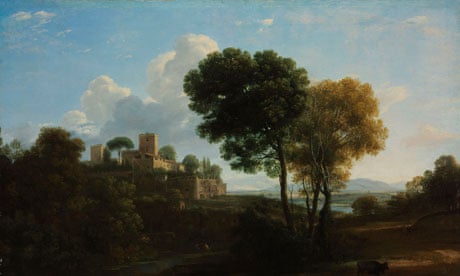In a turbulent century of political, social and economic uncertainty, the artist Claude Lorrain offered an image of the world as a place of calm beauty, where any change would be benevolent.
One of his greatest fans was the polymath Johann Wolfgang von Goethe, who worshipped him for revealing "the world's beautiful soul", and went to Italy specifically to view it through Lorrain's eyes.
A new exhibition of the 17th-century artist's work opens on Thursday at the Ashmolean Museum in Oxford. And while Lorrain may have fallen out of fashion, it aims to demonstrate why he was once one of the most admired and expensive artists in Europe and a particular favourite of the English aristocracy.
"Germany was mad for him too," co-curator Martin Sonnabend said, "but England had the money."
He knows this to his cost: his museum, the Städel in Frankfurt, owns one beautiful Lorrain painting, some etchings, and recently managed to buy one drawing for a painfully large price from an English dealer. When the exhibition closes in Oxford in January it will travel to his museum as some reparation.
By the early 19th century two-thirds of all Lorrain paintings were in English collections, and the British Museum – a major lender to the exhibition – still owns 40% of all his drawings, with scores more and all his etchings in the Ashmolean collection.
"You'll find many a ducal Lorrain on our walls," said Christopher Brown, director of the museum, thanking the many anonymous private lenders for tolerating such big gaps on their walls for so long.
It was the calm, golden certainty of his light, Sonnabend says, that made him so beloved. At the height of the craze he inspired myriad artists, poets, composers, novelists and even landscape gardeners such as William Kent who laid out Rousham gardens near Oxford. Garden visits will be part of the exhibition programme.
The show includes the largest exhibition ever mounted of Lorrain's engravings, which Sonnabend particularly admires, including one extraordinary sequence commissioned by the Spanish ambassador showing the week of spectacle in Rome in 1637, paid for by the Spanish, when one of their own was proclaimed "King of the Romans". In Lorrain's engravings the viewer can follow as in a graphic novel a wine fountain topped with a Hapsburg eagle exploding into fireworks, and a square tower falling apart to reveal first a round tower and then an equestrian statue of the new king.
Jon Whiteley, the senior assistant keeper of western art at the Ashmolean, hopes the exhibition will revive at least an echo of the craze for Lorrain. "It is true that he has fallen completely out of fashion," he conceded sadly. "There is something wrong with the world."
Claude Lorrain: the Enchanted Landscape is at the Ashmolean Museum in Oxford until 8 January 2012.
